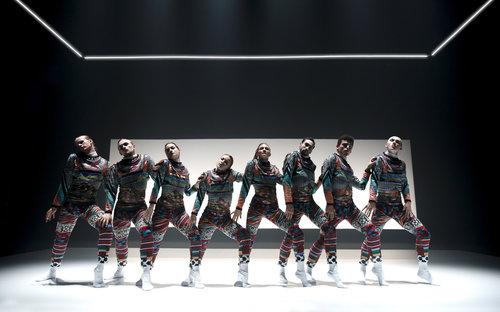National Dance Company Wales is on the road with the Terra Firma triple bill, which in Newport comprised three very different choreographic styles with the common theme of Joe Fletcher’s moody lighting.
Some venues have different mixed programmes, depending on what has toured there before. At Newport we had Caroline Finn’s Folk, Mario Bermundez-Gil’s Atalaÿ and Marcos Morau’s Tundra.
Tundra
Folk
Folk has now been doing the rounds for a while and Tundra was part of the PARADE event that was performed in Cardiff and Bangor last year. Folk won Caroline Finn, who has stepped down and replaced as artistic director, Best Female Dance Artist at Wales Theatre Awards 2017 while Marcos Morau picked up the Best Choreographer Awards in 2018. This only left Mario Bermundez-Gil’s work that was new and perhaps that partly accounted for the disappointingly small audience at the Riverfront. Although perhaps not. It would seem contemporary dance is continuing to be a hard sell to audiences outside the Cardiff bubble and even in the capital shrinkage has been noted. I would suggest a new approach (or return to a previous successful approach?) to attracting audiences is called for. Of course, populist shows like Matthew Bourne still sell well.
These dancers deserve a much bigger audience and hopefully the arrival of the new artistic director Fearghus Ó Conchúir can bring some excitement as, sadly, novelty seems to sell. Having accepted you cannot just expect audience members to turn up at their local venue the company will probably go down the take the dance to the people and, looking at the new artistic director’s style, go for more pop-up style works in perhaps unconventional places. It worked for National Theatre Wales in its moment in the sun heyday for the year or so when it enjoyed great success, so perhaps this is one of the ways forward.
Anyway. This triple bill showcases the largely new band of dancers under the NDCWales banner with few I recognises from recent works. Fortunately, they have the excellent Ed Myhill, winner of Best Male Dance Artist at Wales Theatre Awards 2018, but there did seem a little less edge, sharpness or perhaps just difference to what should have been the bigger hitter, Tundra, which wowed everyone in 2017. Yes, it is still gorgeous, the movement of dancers in a near robotic (dare I say Dalek) style for the opening, after a similarly dressed, masked figure has introduced us to the theme. The skirts are abandoned and the dancers reappear in tight fitting multi coloured one-piece outfits from designer Angharad Matthews, reminiscent of knitted costumes from freezing environments across the northern hemisphere. Patterns emerge, interlocking hands and feet create writhing snake-like designs, interspersed with break outs where one or other performer steps away only to be reabsorbed into the communal melding. Quiet why it didn’t hit home as much is difficult to gauge, a different venue, different context, different dancers?
For the opening work, Folk, the surprise element has been moved from later in the choreography to almost immediately the action opens, but there will still be some who have not seen the show so I will not spoil it. The roots of the tree are suspended over the stage, leave shave fallen and are swept up at the beginning and at the end. This is a more organise chaos work with dancer flying off in their own worlds, their own outcries, their own moments of hysteria. There is the on looking from the community, sometimes disapproving, sometimes supportive and sometimes just, well, there. The costumes from Gabriella Slade are an odd mishmash telling us little of them, their back stories, their own worlds.
The middle of the three dances is the newest work, Atalaÿ, and while I enjoyed this vivacious work, my companions expressed contrasting views over interval drinks. I enjoyed its unashamedly popular feel, they did not. The quartet of dancers (four compass points?) two women, Julia Reider and Nikita Goile and two chaps Ed Myhill and Mathew Prichard, dress in costumes from Brighde Penn that to me conjure up Anatolian folk; baggy pants, short tunics, thick leather belts. Similarly, the entire choreography weaves a hypnotic world of the cultures of what is now Turkey but redolent of Asiatic peoples, music, dance languages and intertwining cultures and religions. Under a scorching sun, it is fast-moving and captivating, even sounding like a flavour of Bhangra had been incorporated, the rhythms are pulse-racing and the movement sensuous. The vocabulary largely evokes traditional dancing, to my eyes also hinting at boxers’ quick steps, jabs and rallies. Like Tundra, it starts with a semi-godlike figure. This almost shamanistic mistress of ceremonies who begins and concludes the ceremonies and some of the use of lighting, particularly towards the spiritual climax was sublime. (The video clip below gives a sort of feel for the dance but is too disjointed to capture its essence effectively).
A taster for Atalaÿ:
Sadly, the company does not give a comprehensive programme any more (shame, as a still minority art form needs to develop its audiences) so I cannot tell you much about the music, it was not mentioned on the basic information sheet given to the audience, but I would have thought it is from Turkey. Atalaÿ translates at Watchtower from Turkish into English. I am not sure if the Spanish choreographer was telling us his vision from Spain and his experience as a dancer working in Israel? Presumably the Terra Firma relates to three dances rooted in different earths.
Atalaÿ’s choreographer talks about his work:
Mario Bermudez Gil: Choreographer of Atalaÿ, NDCWales
New Voices review from Cardiff:
Terra Firma, NDCWales
For the rest of the tour dates visit: ndcwales.com

